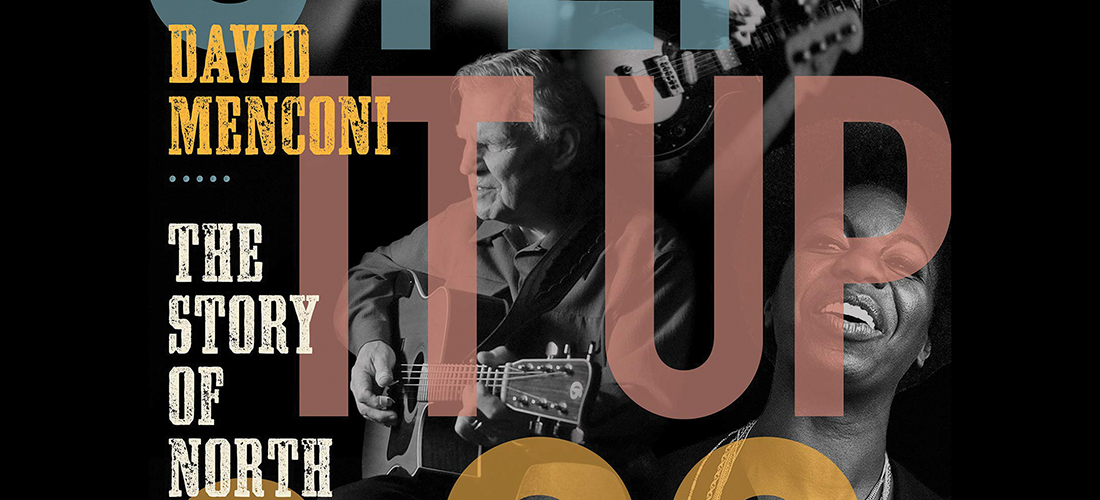
We Got the Beat
The richness of North Carolina’s music
By Stephen E. Smith
In his latest book, Step It Up and Go: The Story of North Carolina Popular Music, from Blind Boy Fuller and Doc Watson to Nina Simone and Superchunk, music critic David Menconi lays it out in the prologue: “Music is North Carolina’s tuning fork — not tobacco, basketball, NASCAR, or even barbecue — because it’s not just in the air here, but also the soul.”
Barbecue gobbling, nicotine-addicted NASCAR/Carolina fans might take exception to Menconi’s premise, but for North Carolinians who have wandered through life with their ears pricked forward, there’s no denying that the state’s popular music scene has played a significant role in defining their identity. Charlie Poole, Blind Boy Fuller, Earl Scruggs, Doc Watson, Nina Simone, James Taylor, the Red Clay Ramblers, Ben Folds, Mandolin Orange, and hundreds of other talented musicians, have, at one time or another, called the state home, and although a self-serving parochialism is at work here, there’s good reason to take pride in the music North Carolina has contributed to the world. We can’t claim a Nashville or an Austin or a New Orleans, but popular music would be a lot less interesting without us. And although the state’s boundaries are an arbitrary and artificial device for identifying musical movements and influences, there’s nothing new in employing “sense of place” as an organizing element. The Oxford American, for example, publishes an annual state music edition, with North Carolina featured in their winter 2018 issue.
If sex — oh, all right, true love — is the primary inspiration for most pop tunes, race has been a troubling subtext in much of the music North Carolina artists have created. What could be a more revealing example than the “beach music” craze of the 1950s and ’60s where crowds of privileged white guys, decked out in patch-madras britches and alligator wing-tipped tasseled Nettletons, shuffled to sexually implicit dance candy produced almost exclusively by Black artists who wouldn’t have been allowed admission to the venues where they were performing?
Menconi’s compendium is generally arranged chronologically, with scant attention paid to music as folklore (we’re talking “popular” music here), and Bascom Lamar Lunsford is as close as Menconi comes to crediting traditional influences. The rough and tumble antics of Charlie Poole and his North Carolina Ramblers is his starting point in “Linthead Pop.” Poole, who was born and raised in Randolph County and spent much of his life working in cotton mills, thrived musically in and around North Carolina in the 1920s and ’30s, and his influence on popular music has waxed and waned with changing tastes. Nevertheless, he remains an essential, almost mythical figure in the history of the state’s music.
Piedmont blues artists who worked the Bull City tobacco markets receive their due in chapter two: Blind Boy Fuller, the Rev. Gary Davis, Sonny Terry, Brownie McGhee, Elizabeth Cotton and Etta Baker are credited with influencing popular artists well into the 21st century.
“Through the Airwaves” is a much-deserved tribute to Charlotte-based Arthur Smith, whose superb musicianship and entrepreneurial savvy brought North Carolina music into the mid- to late-20th century. Menconi writes: “Smith didn’t just figure out syndication and diversification but vertical integration, controlling the means of production” by establishing a studio in Charlotte that catered to “the likes of Statler Brothers, Flatt & Scruggs, James Brown, and Johnny Cash.” Smith’s copyright infringement suit over “Dueling Banjos,” a 1972 hit from the movie Deliverance, is explicated in detail, correcting lingering misconceptions concerning the tune’s authorship and Smith’s strategic lawsuit against industry giant Warner Brothers.
Greensboro readers will appreciate Menconi’s focus on The 5 Royales, a Triad-based gospel-inspired group who enjoyed nationwide popularity in the ’50s and early ’60s. Best known for having written and recorded “Dedicated to the One I Love” — later covered by the Shirelles and the Mamas and the Papas — the Royales’ story is one of hard work and little pay. What should have amounted to considerable income from record royalties never materialized. After the Royales’ singer-songwriter Lowman Pauling’s death, his wife received a check for $6. “I hate to say it,” Pauling’s son observes, “but in the Jim Crow South, black people got the shaft.”
Doc Watson, the Appalachian flat picker who’s an institution for North Carolinians, is the subject of a thoroughly researched chapter that will enlighten even longtime Watson fans, and the benighted beach music craze is given more than adequate attention in a chapter ironically titled “Breaking the Color Lines at the Beach.” The hit-and-miss career of Eastern North Carolina’s Nantucket is detailed in “The Eight-Track Era of Rock and Roll,” and Chapel Hill is dubbed the “Next Seattle” in an essay that celebrates Ben Folds and the Squirrel Nut Zippers.
Menconi examines the rise of North Carolina record labels, including Colonial, Sugar Hill and Merge records, and the popularity of Americana, Alternative, and Hip-Hop is explored through the music of the Avett Brothers, the Carolina Chocolate Drops, the Kruger Brothers, Mandolin Orange, the Backsliders, and 9th Wonder and Little Brother.
Of particular interest is Menconi’s appreciation of the great Nina Simone, a Tryon native whose immense talent was shaded by her railings against racial injustice. She and other Black artists fled the state. “That’s especially the case with jazz,” Menconi writes, “starting with Thelonious Monk, John Coltrane, and Max Roach. . . . And after Blind Boy Fuller died in 1941, his Durham blues peers Sonny Terry, Brownie McGhee and Rev. Gary Davis all decamped to the North.”
Sprinkled throughout the text are sidebars that recognize artists of particular merit — the Steep Canyon Rangers, Chatham County Line, Shirley Caesar, Tift Merritt, the Embers, James Taylor, John D. Loudermilk, Link Wray, Rhiannon Giddens and many others. Still, it’s impossible to get it all in. There’s just too much good stuff to fit into 300 pages, and many fans will be mildly disappointed to find their favorite musician omitted.
Still, Menconi provides a valuable service to North Carolina music lovers, a well-researched and beautifully written primer that’s essential in understanding the state’s contribution to popular music. Moreover, he establishes a jumping-off point from which yet-to-be-written books might explore with more specificity the state’s musical diversity by region and genre. PS
Stephen E. Smith is a retired professor and the author of seven books of poetry and prose. He is the recipient of the Poetry Northwest Young Poet’s Prize, the Zoe Kincaid Brockman Prize for poetry and four North Carolina Press Awards.





